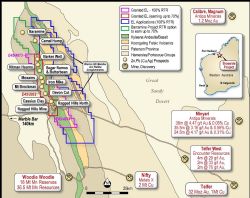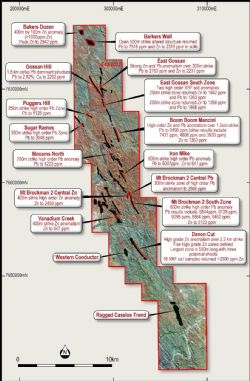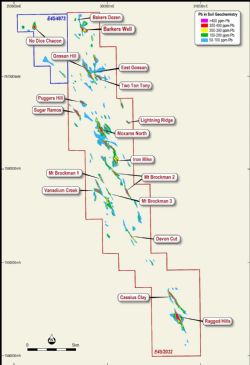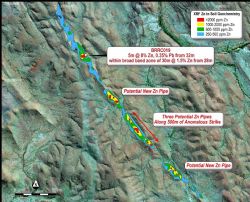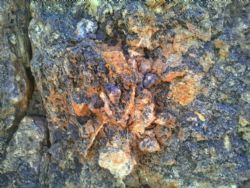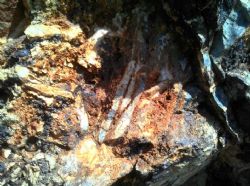 Braeside Exploration Update - Multiple New Drill Targets
Braeside Exploration Update - Multiple New Drill Targets
Perth, June 5, 2018 AEST (ABN Newswire) - Rumble Resources Ltd ( ASX:RTR) ("Rumble" or "the Company") is pleased to announce that the completion of the first stage of pXRF soil sampling within E45/2032 and regional soil sampling in E45/4873. The exploration has highlighted a multitude of first order Zn and Pb targets associated with large northwest to north trending alteration zones inferred to be feeder structures to a porphyry related mineralising system and Zn rich disseminated mineralisation in siltstone.
ASX:RTR) ("Rumble" or "the Company") is pleased to announce that the completion of the first stage of pXRF soil sampling within E45/2032 and regional soil sampling in E45/4873. The exploration has highlighted a multitude of first order Zn and Pb targets associated with large northwest to north trending alteration zones inferred to be feeder structures to a porphyry related mineralising system and Zn rich disseminated mineralisation in siltstone.
Highlights
- In addition to the new high-grade zinc discovery defined by a single RC drill hole at the Devon Cut Prospect (BRRC019 - Nov 2017 - 5m @ 8.0% Zn, 0.35% Pb from 32m) (see Note below):
o Five (5) new first order targets with the potential for high grade breccia Zn pipes have been outlined by detailed 25m by 25m pXRF in soil (in-situ) sampling along a highly altered sericite - silica - chlorite structure over 2.2 km in strike and up to 30m in width.
o The new targets have been defined by >2000ppm Zn in soil contouring with peak Zn value of 5776 ppm and Pb value of 6010 ppm. The largest zone (550m strike) contains three (3) potential high-grade Zn breccia pipes.
o The new targets have a similar or higher order Zn response and size to the high-grade Zn discovery RC drill hole (BRRC019)(see Note below) geochemical parameters.
- Fifteen (15) zones have now been delineated with twenty-three (23) first order targets within E45/2032. At least two styles of base metal anomalism (representing targets) have been recognised.
- Zn and Pb mineralisation associated with multiple highly altered (up 100m in width) silica - sericite - chlorite fracture/feeder zones over significant strike lengths. Zones additional to Devon Cut include:
o Mt Brockman 2 South - 800m strike with very high grade Pb in soils including 9844 ppm, 9728 ppm and 9295 ppm Zn in soils to 2123 ppm.
o Boom Boom Mancini - 1.5 km strike with very high-grade Zn and Pb in soils including 9496 ppm Pb, 7427 ppm Pb and 1363 Zn.
- Widespread disseminated Zn mineralisation in altered siltstones.
o Mt Brockman 2 Central Zn - Strongly pervasive disseminated Zn in altered volcanogenic siltstone over 400m strike returning up to 2459 ppm Zn.
o Baker's Dozen - Open 400m strike disseminated Zn in siltstone with values to 2942 ppm (Zn).
- Rumble's field crew is currently completing detailed grab sampling and prospect mapping to optimise the proposed RC drill-hole program at all twenty-three (23) first order drill targets
Fifteen (15) high-grade Zn and/or Pb anomalous zones with twenty-three (23) first order targets, have been delineated by detailed pXRF soil sampling of the main Zn and/or Pb soil anomalies that were generated during the 2017 field season within E45/2032.
Following the discovery of the Devon Cut high-grade Zn mineralisation with RC drilling November last year, Rumble has been aggressively exploring over the last two months systematically using surface geochemistry to delineate high order targets ready for the upcoming RC drilling programme.
Note: Follow up grab (rock chip) sampling and prospect geological mapping is ongoing with results pending.
Geochemistry Programme
pXRF Soil Sampling - Image 2 (see link below)
Broad-spaced high order base metal in soil anomalism (defined in 2017) has been tested in detail by survey controlled in-situ pXRF soil analysis. A total of 2565 sample locations were tested within E45/2032. The pXRF soil programme involved 50m by 50m grids, 25m by 25m infill grids and multiple single line 25m spaced traverses along strongly altered structures/fractures over many kilometres in strike. The sampling medium was soil only (0 to 1cm depth). Standards and blanks were used for the pXRF analysis.
Regional Soil Sampling - E45/4873 - See Image 3 (see link below)
Wide spaced (400m by 400m) and select 200m by 200m regional soil sampling has been completed within E45/4873. A total of 195 soil samples were collected for multi-element wet analysis.
Exploration Results and Targets (Image 2 for Locations) (see link below)
pXRF Soil Sampling Results and Targets
Sampling has delineated fifteen high order zones with 23 high priority targets. The criteria used to rank targets include >800 ppm Zn and/or Pb in soil, > than 200m of strike with significant alteration.
Devon Cut Prospect (5 additional targets to the Zn discovery) - Image 4 (see link below)
The Devon Cut discovery (RC drilling by Rumble Nov 2017) has highlighted the potential for high-grade Zn breccia pipes within large altered northwest and north trending structures throughout the Braeside Project. A single hole (BRRC019)(see Note below) targeted on high-grade surface rock chip Zn and Pb mineralisation returned 5m @ 8.0% Zn, 0.35% Pb from 32m (inc 1m @ 21% Zn, 0.97% Pb from 34m). The high-grade intercept was within a broad zone of zinc anomalism (30m @ 1.5% Zn from 28m).
Detailed pXRF soil sampling (25m by 25m grid) along the Devon Cut mineralised structure has highlighted a further five (5) high-grade Zn targets with the potential for significant high-grade breccia Zn pipes. Zn in soils returned values to 5776 ppm and Pb to 6010 ppm. The high-grade Zn zones are defined by the >2000 ppm soil contour. Over 18 samples sites returned >2000 ppm Zn.
The largest zone (over 500m in strike) comprises three high-grade core zones with visible Zn carbonate gossan. Strongly anomalous Pb is associated with the Zn in soil anomalism. Cu is also elevated. All three core zones have a similar or higher tenor (and dimensions) compared with the discovery mineralisation (BRRC019).
All anomalous Zn zones are highly altered with pervasive silica, sericite and strongly chloritised wall rock. Zones range from 10m to 30m in width.
Oxidised breccia pipe characteristics have been observed within the target areas:
- Strong desilification zones peripheral (broad selvages) to the potential breccia sulphide pipes are represented by manganiferous vuggy/open textured siliceous matrix rocks with Zn and Pb secondary minerals (see image 5 in link below).
- Oxidised mineralised breccia zones (see image 6 in link below) potentially represent hydrothermal sulphide (Zn) breccia pipes.
Examples of pipe-like base metal deposits include: The Elura Zn - Pb - Ag mine (Cobar, NSW). Elura comprises of 6 pipes ranging from 120m to 30m in diameter - pre-mining resource of 50.7 Mt @ 8.8% Zn, 5.6% Pb, 107 g/t Ag and 0.2% Cu.
Mt Brockman 2 South (two targets)
- Significant Pb in soil anomalism has been defined over a strike of 800m. Results include up to 9844 ppm Pb adjacent to the old Mt Brockman 2 Pb mine, however, south along strike (150m) results include up to 9295 ppm Pb in soils. Approximately 150m north of the old Mt Brockman 2 Pb mine, results include up to 9728 ppm Pb with up to 2123 ppm Zn. The high order base metal in soil anomalism is associated with moderate widths (5 to 10m) of intense silica - sericite alteration. Both zones are considered worthy drill targets.
Mt Brockman 2 Central Pb (one target)
- Strong Pb in soil anomalism is associated with intense kaolinite - sericite - silica alteration with widths of up to 10m. Pb to 2866 ppm is associated with a strike of 300m.
Mt Brockman 2 Central Zn (one target)
- Strong Zn in soil anomalism is associated with a north trending altered structure with a strike of 400m. Pervasive alteration (silica - chlorite - sericite) of fine grain intermediate tuffs in contact with a silica altered quartz zone returned up to 2459 ppm Zn.
Iron Mike (One target)
- Highly anomalous Pb in soils to 6007 ppm (Pb) trends northwest over a strike of 500m. Strong silica-sericite alteration with widths to 10m also has elevated Zn in soils to 641 ppm (Zn).
Boom Boom Mancini (two targets)
- Anomalous Zn and Pb in soil occurs over a strike of 1.5km in association with silica-sericite alteration. Two core zones returned very high grade Pb including 9496 ppm, 7427 ppm, 4804 ppm and 3803 ppm. Zn was also strongly anomalous including 1771 ppm, 1362 ppm and 1326 ppm.
East Gossan South Zone (two targets)
- Two highly anomalous Pb and Zn zones have been defined along a north trending prominent structure with intense silica - sericite - chlorite alteration. Stringer galena and sphalerite was observed in completely chloritised wall rock. Massive galena was observed with the silica sericite alteration. The northernmost zone returned Zn to 1894 ppm and Pb to 1263 ppm over a strike of 250m. The southernmost zone returned Zn to 1268 ppm and Pb to 1868 ppm over a strike of 200m.
East Gossan (one target)
- Zn to 2237 ppm and Pb to 2763 ppm occurs in soil over a strike length of 300m in association with silica - sericite alteration.
Barkers Well (two targets)
- Widespread alteration with elevated Zn and Pb from a single RC drill hole has been followed up by a 50m by 50m XRF soil sampling grid. BRRC036 (Nov 2017)(see Note below) returned 124m (entire hole) @ 0.19% Pb, 900 ppm Zn in association with silica - sericite - chlorite alteration. Zn to 2319 ppm and Pb to 7516 ppm has highlighted at least two new targets including a north trending structure with known small-scale workings (500m in strike and completely open).
Baker's Dozen (one target)
- Zn anomalism is associated with a flat lying siltstone overlying dolomite without any obvious altered structure. Zn in soils to 2942 ppm highlights a north trending lithological unit over a strike of 400m (completely open) and over 100m in width. Visual inspection of the siltstone identified disseminated sphalerite.
Gossan Hill (one target)
- Very high grade Pb in soils to 2.82% with associated Cu to 2292 ppm occurs along a Pb dominant mineralised section of the Gossan Hill structure. The section, 1.8 km in strike, is a topographical high in the area and is altered (silica - sericite) over 50m in width where the high order Pb and Cu is located.
Puggers Hill (one target)
- Strong Pb in soil anomalism is associated with a northwest trending alteration (sericite - silica) zone. Pb in soil returned up to 1128 ppm and Zn to 837 ppm over a strike of 250m.
Sugar Ramos (one target)
- Strong potassic - barite - silica - sericite associated with visible multiple galena veins occurs over a strike of 350m. Pb in soil returned up to 3048 ppm.
Moxams North (one target)
- Very high-grade Pb in soils are associated with a northwest trending wide alteration (sericite - silica) over a strike of 200m. Pb returned up to 4222 ppm.
Vanadium Creek (one target)
- Strongly anomalous Zn in soils occurs over a strike of 400m within a major northwest trending structure. Zn returned up to 947 ppm.
Regional Soil Sampling Results - No Dice Chacon target - Image 3 (see link below)
Wide spaced (400m by 400m) conventional soil sampling has defined a 700m strike, north trending zone of Zn anomalism (up to 560 ppm Zn) in flat lying siltstones at the No Dice Chacon target within E45/4873.
The response is significant (8 times background) based on soil sampling completed further east at the Baker's Dozen target where regional Zn in soil anomalism returned 527 ppm Zn has been infilled (50m by 50m) by pXRF soils where values were up to 2942 ppm Zn.
Comments on Soil Geochemistry Thresholds
Note that the pXRF in-situ soil programme focused on the mineralised structures and anomalous standard/traditional regional soil geochemistry and therefore the sample sites are proximal or directly over base metal mineralisation in basement. The thresholds (assay response - Pb and Zn) will be higher order compared with the regional standard/traditional soils. Regional soils are spaced on 400m by 400m staggered patterns with infill to 200m by 100m patterns. pXRF soil sampling is on 50m by 50m, 25m by 25m and 25m single line spacing grids over base metal anomalism defined by the regional soil programs.
Exploration Status
Rumble is aggressively completing systematic targeting with detailed prospecting of the defined targets ongoing. Work includes extensive multi-element grab/rock chip sampling and geological reconnaissance. Results are pending for approximately 200 grab samples taken over the high order base metal targets.
As the exploration progresses, numerous high priority targets are being generated and Rumble is optimising the best targets for the proposed RC drilling program. Due to the multitude of first order targets being identified, the RC drilling is now re-scheduled for August to ensure Rumble delineates the best targets for the RC drill program.
Note: Refer to RTR announcement 22 Feb 2018 - "Further Sampling Confirms High Grade Zinc Discovery and Identifies High Grade Vanadium Potential at Braeside"
To view figures, please visit:
http://abnnewswire.net/lnk/15480666
About Rumble Resources Ltd
 Rumble Resources Limited (ASX:RTR) (FRA:20Z) is an Australian based exploration company, officially admitted to the ASX on the 1st July 2011. Rumble was established with the aim of adding significant value to its current gold and base metal assets and will continue to look at mineral acquisition opportunities both in Australia and abroad.
Rumble Resources Limited (ASX:RTR) (FRA:20Z) is an Australian based exploration company, officially admitted to the ASX on the 1st July 2011. Rumble was established with the aim of adding significant value to its current gold and base metal assets and will continue to look at mineral acquisition opportunities both in Australia and abroad.




![abnnewswire.com]()
Related Companies
Social Media
Share this Article

 ASX:RTR) ("Rumble" or "the Company") is pleased to announce that the completion of the first stage of pXRF soil sampling within E45/2032 and regional soil sampling in E45/4873. The exploration has highlighted a multitude of first order Zn and Pb targets associated with large northwest to north trending alteration zones inferred to be feeder structures to a porphyry related mineralising system and Zn rich disseminated mineralisation in siltstone.
ASX:RTR) ("Rumble" or "the Company") is pleased to announce that the completion of the first stage of pXRF soil sampling within E45/2032 and regional soil sampling in E45/4873. The exploration has highlighted a multitude of first order Zn and Pb targets associated with large northwest to north trending alteration zones inferred to be feeder structures to a porphyry related mineralising system and Zn rich disseminated mineralisation in siltstone.  Rumble Resources Limited (ASX:RTR) (FRA:20Z) is an Australian based exploration company, officially admitted to the ASX on the 1st July 2011. Rumble was established with the aim of adding significant value to its current gold and base metal assets and will continue to look at mineral acquisition opportunities both in Australia and abroad.
Rumble Resources Limited (ASX:RTR) (FRA:20Z) is an Australian based exploration company, officially admitted to the ASX on the 1st July 2011. Rumble was established with the aim of adding significant value to its current gold and base metal assets and will continue to look at mineral acquisition opportunities both in Australia and abroad.


